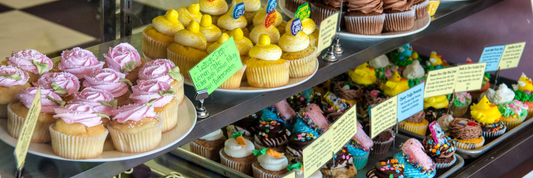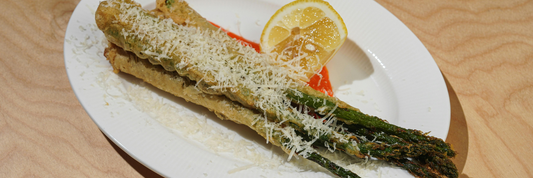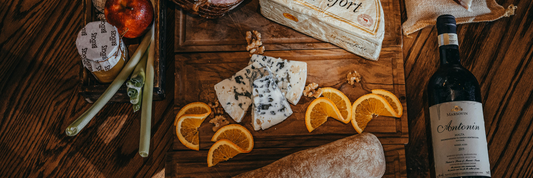Have you ever noticed how a small poster placed right at the checkout counter can make customers decide to order an extra dessert or try a new drink?
In the F&B industry especially for coffee shops, restaurants, and small beverage stores visual merchandising at the point of sale often acts as a “silent salesperson” that drives effective upselling.
However, not every poster or standee can capture customers’ attention long enough to spark curiosity. A design that lacks finesse, uses reflective materials, or feels too rigid can easily cause your message to fade away within seconds.
In this article, Kimecopak will share strategies and a practical checklist to help you design posters and standees that effectively upsell new menu items covering everything from color choices and layout to materials and ways to measure real-world performance.
-
Review Marketing: How to Encourage Customers to Share Their Experiences
-
Loyalty Programs: Do Point Systems Work for Sushi/Ramen Restaurants?
- 5 Branding Strategies for Sushi/Ramen on Instagram
Why Posters & Standees Matter for Upselling

1. The Role of Visual Merchandising in F&B
In hospitality, every visual cue influences a customer’s behavior. Posters and standees serve as “micro touchpoints” subtle but powerful triggers that remind customers to try something new.
2. How Posters Influence Purchase Decisions
According to GloriaFood, well-designed visuals can increase sales by up to 30%, especially when placed strategically at the point of sale.
Similarly, Goboxad notes that restaurant posters placed near entrances or counters significantly boost visibility and impulse buying.
3. Define Your Objective
Before starting the design, clarify your goal:
- Are you launching a new dish or a seasonal item?
- Is the purpose to drive immediate sales or build awareness?
Your objective will determine the headline, image tone, and call-to-action (CTA) on your poster.
Know Your Audience & Message Before You Design

Understand Your Target Guests
Different audiences respond to different messages:
- Regulars want novelty and freshness.
- New visitors need clarity and visual appeal.
- Takeaway customers prefer convenience and quick interactions a QR code helps them act fast.
Craft a Core Message That Sells
Ask yourself: Why should my customer try this item?
Example: “Made with locally sourced ingredients available this week only.”
Keep the message clear, emotional, and benefit-driven.
Stay Consistent with Brand Identity
Your visual design should echo your brand’s values.
For a premium, sustainable brand like those that partner with Kimecopak:
- Use clean, minimalist layouts
- Choose eco-friendly printing materials
- Select neutral, elegant color palettes that reflect sophistication
Your poster or standee is the first impression of your new dish make it speak your brand language.
Design Elements That Drive Engagement & Upsell

Create Visual Hierarchy
A strong hierarchy helps customers process information in seconds:
- Bold, concise headline
- Mouth-watering product image
- Short supporting text
- Clear CTA — e.g., “Try It Today” or “Limited Time Only”
As Toast POS notes, effective hierarchy shortens decision-making time and increases conversions.
Use Color, Typography & Imagery Wisely
- Colors: Choose bold but harmonious shades; limit your palette.
- Images: Use high-resolution, natural-light shots. Avoid stock photos or over-edited images.
- Typography: Stick to 1–2 fonts for a professional look.
Choose the Right Placement & Size
Where you display your standee or poster matters:
- Place posters near entryways or counters for maximum visibility.
- Keep standees tall and slim, ensuring they don’t block traffic flow.
- Consider lighting and viewing distance for best impact.
Add QR Codes or Smart CTAs
Bridge offline and online engagement:
- Add a QR code linking to your menu or loyalty program.
- Use clear CTAs like “Scan to Order” or “Get 10% Off Today.”
This lets you measure direct engagement and conversion.
Content Checklist & Layout Best Practices

Poster/Standee Content Checklist
- Compelling headline
- High-quality image
- Key benefit or story
- Time-limited offer
- CTA or QR code
- Logo & tagline (e.g., “Kimecopak – Green Packaging for F&B”)
- Brand-aligned colors & fonts
- Balanced white space
Copywriting Dos & Don’ts
DO:
- Keep sentences short and clear
- Use sensory language (“crispy,” “refreshing,” “locally roasted”)
- Focus on emotion and value
DON’T:
- Overcrowd the design
- Use small fonts or unreadable contrasts
- Include too many pricing details
- Use low-quality images
Sustainability & Material Choices
Choose Eco-Friendly Materials
For brands embracing sustainability, the design process should also reflect eco-conscious values:
- Use recycled paper or FSC-certified boards
- Opt for eco-inks and water-based coatings
- Choose modular standee frames for easy content replacement
By doing so, you reinforce your green commitment a value central to Kimecopak’s mission.
Extend the Product Lifecycle
A good design can serve multiple campaigns:
- Keep the frame reusable, only swap printed inserts
- Store materials properly to prevent damage
- Recycle outdated materials responsibly
This not only saves cost but aligns with sustainable branding.
Measuring Success & Iterating
Key Metrics to Track
To know if your poster is truly working:
- % of customers ordering the new item
- Change in average order value
- QR code scans or link clicks
- Customer dwell time around the display
A/B Testing Ideas
Experiment with:
- Placement (entrance vs counter)
- Headline wording
- Image type (product-only vs lifestyle photo)
- Poster size or format
Review performance weekly to identify winning designs.
When to Refresh
- For limited-time items → replace after the campaign
- For long-term products → update visuals seasonally
- Always replace worn or faded materials promptly
Consistency in quality equals consistency in trust.
Real-World Example & Template for F&B Brands

Example Layout
Headline: “Introducing Our New Matcha Latte – A Green Twist on a Classic”
Image: Bright, minimalist shot of the drink on a wooden table
Subtext: “Made with organic matcha and plant-based milk – this week only.”
CTA: “Scan to order & save 10% today.”
Footer: Kimecopak logo + tagline “Sustainable Packaging for F&B Businesses”
Material: Recycled kraft board, eco-friendly ink
Adaptation for Small Cafés
- Use A2-sized posters instead of full standees
- Display near the counter or pickup window
- Combine with tabletop QR cards for extra reach
FAQ
Q1: Do posters and standees really help upsell new items?
Yes. When strategically designed and placed, posters can trigger impulse decisions and increase item visibility. According to Goboxad, posters near POS areas are among the most effective promotional tools.
Q2: Should I include food images or keep it text-based?
High-quality food images typically perform better. GloriaFood reports that adding vivid visuals can boost menu item sales by up to 30%.
Q3: How do I choose between a poster and a standee?
- Use posters for smaller spaces (A2–A1)
- Use standees in larger, open areas like lobbies or entrances
Q4: How often should I change my designs?
Refresh posters every 4–6 weeks or after each campaign. For sustainable branding, reuse frames and print only new inserts.
Q5: How can I measure the poster’s performance?
Track QR scans, item sales, customer feedback, and A/B test results to continuously improve your visuals.
-
LEARN MORE about How "Subscribe for a Happy Life" will benefits your business HERE!
-
LEARN MORE about Kim Vu, sharing on the challenges she faced as a former restaurant owner, and how she overcame them to create KimEcopak HERE!




